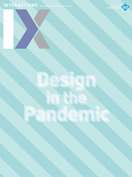Authors:
Peter Dalsgaard
The Covid-19 pandemic has spread across the globe at lightning speed, with massive consequences. Our lives and societies have been suddenly transformed. Many of us have a sense that when the first wave of the pandemic has passed, so much will be different.
As my country, Denmark, was going into lockdown in an effort to limit the spread of the virus, I initiated a shared document [1], inviting researchers and practitioners in the HCI and interaction design community to propose how we might use our resources and competences to contribute, both in the immediate crisis and in the phases that follow. Within a matter of hours, peers from all parts of the globe were sharing constructive and critical proposals and perspectives. In this article, I reflect on how these proposals offer useful perspectives on the current moment, and how the crisis may prompt or force us to break with how we have done things in the past. Broadly speaking, the proposals fall into three categories:
 |
In the wake of the Covid-19, face shields are now being produced in the Ars Electronica Center's MaterialLab using 3D printers. |
- What can we do right now to help? The immediate question that pops to mind for many people is whether we can do something immediately to push the needle in the right direction. The most-discussed topic in the document is fabrication, for example, 3D printing protective gear, medical components, and even makeshift ventilators in a time when these supplies are in massive demand. Moreover, contributors offer ways in which current and novel initiatives can ensure crisis coordination, support communication and combat misinformation, mitigate the social isolation and psychological isolation that result from countrywide quarantines, and help create interfaces and infrastructures for tracing and limiting the spread of the virus.
- How can we contribute to shaping the new normal? While the situation is dire in many countries, this, too, shall pass, and societies will reopen. But what will the new normal look like, and how can we help shape it? Some contributors focus on the particular toolsets and mindsets we have for imagining and designing for the near future, exemplified in methods such as scenarios, design fictions, and participatory design involving the people with whom we will share this future world. Other proposals are more concrete, such as supporting and developing new forms of remote work and remote social communication, reshaping our cities through urban infrastructures and smart city initiatives, and, in a more direct response to the threat of epidemics, increasing our efforts to develop better systems for science labs and sharing scientific findings.
- How are our lives changing as a result of the crisis? A third set of contributions revolves around understanding and reflecting on how the crisis impacts our lives and societies. These span from studying how existing technologies are employed, hacked, and reappropriated to cope with the suddenly different circumstances under which we live and work, to developing art and culture for the crisis, both in terms of rethinking how art can be shared without physical co-presence and also how it can help us reflect upon the crisis. This set also includes broader explorations of what appears to be a radical shift in our world, such as ethnographic studies of the shift from the pre-pandemic to the post-pandemic world, and inquiries into the wider politics of technoscience in the pandemic and its aftermath. These prompt us to consider how technology is intertwined with politics and power relations. We are quick to jump to technological solutions, but we should also consider if and when technology is the answer, or if it might even exacerbate crises.
Reflecting on the discussions that unfold in and around the multitude of proposals, it is evident that there is in our community an urgent desire to help change things for the better. It is also clear that we should uphold our traditions and fora for balancing constructive efforts with critical considerations of what better means, to whom and in which context.
1. https://docs.google.com/document/d/19_n2yjBZeAw8wIbi-aKhzs65cVKrWJEKx_KNfG4TOLM/edit
Peter Dalsgaard is a professor of interaction design at Aarhus University and director of the Center for Digital Creativity. His work explores the design and use of digital systems from a humanistic perspective, with a focus on collaborative design and creativity. [email protected]
Copyright held by author. Publication rights licensed to ACM.
The Digital Library is published by the Association for Computing Machinery. Copyright © 2020 ACM, Inc.








Post Comment
No Comments Found